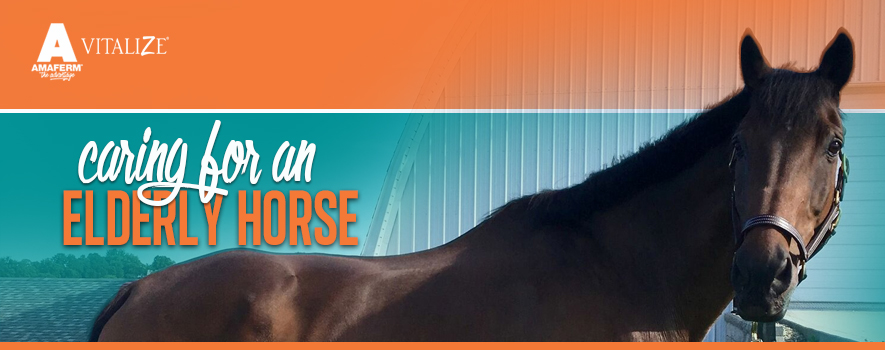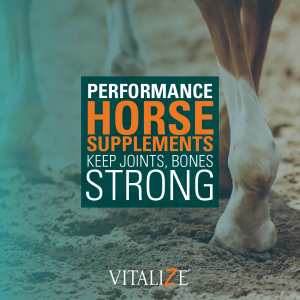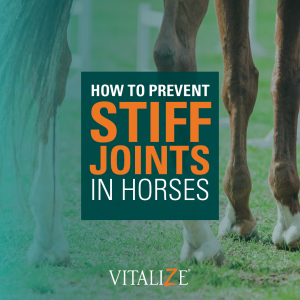by Lisa Norton, BioZyme Vice President
A much-loved, aging horse is something none of us really like to think about. As the owner of a 25-year-old Hanoverian that at one time took my daughter to third in the nation, and the Vice President for an animal nutrition company, I think about whether I am doing all I can for “Tubby” daily.
After you read the below article on the Care of Elderly Horses, provided by Julie Wilson, DVM, College of Veterinary Medicine, University of Minnesota, you will be better equipped to care for your aging friend, and also understand why feeding Amaferm® to him or her is so important.
Aging horses have diminished absorptive capacity which leads to weight loss or loose manure. As a person who has fed Amaferm to Tubby everyday since being hired by BioZyme® in 2006, I can tell you that his manure is perfect. It makes cleaning the stall a breeze. Since a healthy digestive system is the largest contributor to overall health, making sure your aging friend is digestively healthy means less sickness, despite the fact that elderly horses are more susceptible to infections.
After reading the below information on care for the elderly horse, think about the information and consider how adding Amaferm can add to your friend’s digestive health.
Many horses and ponies can live into their 20’s or even 30’s with good health care. These equine senior citizens play many roles for their owners, providing trustworthy mounts for new riders, children, and people with special needs as well as companionship to other horses and their owners. Like people, their health needs shift as their bodies age.
Impact of aging on body systems
- Digestive tract: Dental issues arise as teeth wear out or are lost. Diminished absorptive capacity of the intestinal tract can lead to weight loss or loose manure. A higher likelihood of some types of colic such as small intestine obstruction by a lipoma (fat tumor) requires prompt attention.
- Musculoskeletal system: Arthritis of multiple joints may cause stiffness or limit the range of motion with exercise. Laminitis (founder) may occur if the horse develops Cushing’s syndrome. Muscle wasting may develop, particularly over the horse’s topline.
- Immune system: A mild reduction in efficiency of response to microbes leads to increased susceptibility to infections. This vulnerability is significantly greater if the horse develops Cushing’s syndrome, which causes high blood levels of cortisol, a hormone which further diminishes the immune system’s responsiveness.
- Respiratory system: Recurrent airway obstruction (heaves), the horse equivalent of asthma, tends to progress with time, and affected horses may need more active medical and environmental management as they age.
- Reproductive system: Fertility in both mares and stallions declines. Sperm quality and quantity may limit conception rates. In mares, there is age-related progressive degeneration of the uterine lining which is responsible for the exchange of nutrients from mare to fetus, and the eggs produced by the ovaries are less fertile. This means that the pregnancy is more difficult to achieve and sustain.
- Cardiovascular system: Age related changes may impact the heart or blood vessels, leading to heart failure or sudden death if a major vessel ruptures.
- Nervous system: Coordination may diminish slightly, resulting in a decline in agility. Arthritic changes in the neck or degeneration of the spinal cord can result in progressive incoordination.
- Endocrine system: Abnormal hormone production by the pituitary gland at the base of the brain results in Cushing’s syndrome, which is characterized by progressively more severe signs, including poor shedding of winter coat and premature winter coat in the fall, greasy skin, increased thirst and urination, founder, and increased susceptibility to infections.
Health care suggestions for elderly horses
Work with your veterinarian to make a proactive plan for your horse. Depending on the horse’s age and condition, annual or semiannual physical examinations should be done for early detection of problems. This examination should include assessment of dental needs, weight tape and body condition score, soundness check, and vaccine planning. Close inspection for early signs of cancer is also warranted. Gray horses often develop lumps, melanomas, under the skin. These should be monitored for size at each examination. White skin in areas with little or no hair coat, such as around the eyes, muzzle, vulva, and penis, should be checked for any reddened or raised areas that could be squamous cell carcinomas. If detected early, local treatment is often successful. If the horse or pony is still being ridden, this is a good time to look at saddle fit, as the less muscular back of the elderly horse is more likely to develop saddle sores. Routine blood screening and urinalysis for more subtle signs of age-related internal organ problems may be a good idea for your horse too. You and your veterinarian can then use all of the examination findings to plan health care and nutrition for the next 6-12 months.
Nutrition
Elderly horses benefit from at least yearly attention to their teeth and a high quality diet. Most major feed companies now make “senior” diets, which are typically pelleted, easy to chew, and more energy dense than other concentrates. A horse can be fed a senior diet in addition to hay or pasture to improve its body condition, if it is having trouble maintaining its weight without an apparent health problem. Senior pellets can be fed in larger volumes as the sole feed for the horse, particularly if its teeth are worn past the point of effectively chewing hay. Palatability may vary between brands, so if the horse is not eager for more, try another brand. However, follow feeding instruction carefully, and insure that adequate amounts of vitamin and trace mineral are being supplemented.
Soundness
Horses need regular feet trimming throughout their lives. Good hoof balance promotes even weight bearing, and less stress on the joints. Joint friendly supplements like glucosamine with chondroitin sulfate may help some arthritis horses get around, or a low dose of anti-inflammatory drugs such as phenylbutazone may be needed to keep the horse comfortable. Daily light exercise or turn-out as well as longer warm-up and cool down will also help maintain the horse’s usefulness. Specific joint therapy may be needed if the horse is lame, such as intraarticular medications, or shock wave therapy.
Cushing’s syndrome
If a horse keeps its winter coat longer than its herd mates and starts to grow the winter coat a bit early in the fall, Cushing’s Syndrome may be responsible. Founder without apparent cause is another reason to suspect this syndrome. Management consists of clipping the untimely coat, and suppression of the excessive hormone production from the pituitary, using daily medications such as pergolide. Particularly if left untreated, these horses are more susceptible to infections.
Vaccinations and deworming
As the immune system wanes, elderly horses become more susceptible to microbial diseases and parasites. Retirement is no reason to stop routine health care. Indeed, if the elderly horse is kept with active show horses, they may need more frequent vaccinations, particularly against the respiratory diseases such as strangles, herpes and influenza.
Reviewers: Harland Anderson, DVM; Ron Genrick and Abby Duncanson, Assurance Feeds; and Brenda Postels, University of Minnesota.


